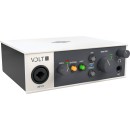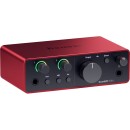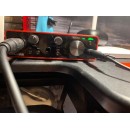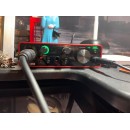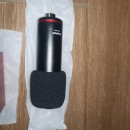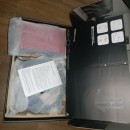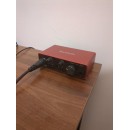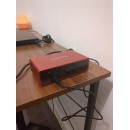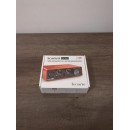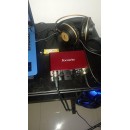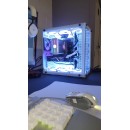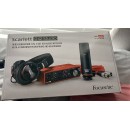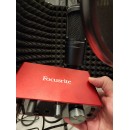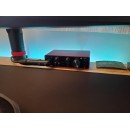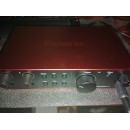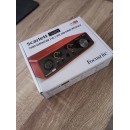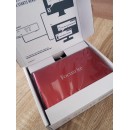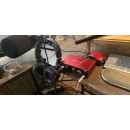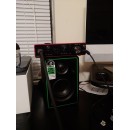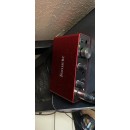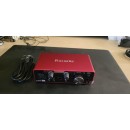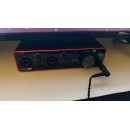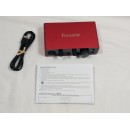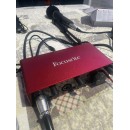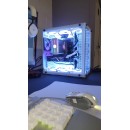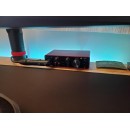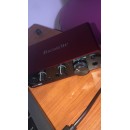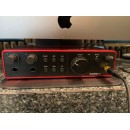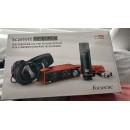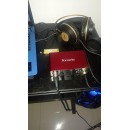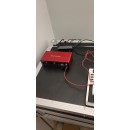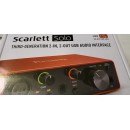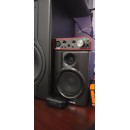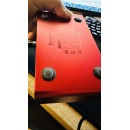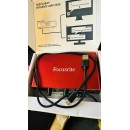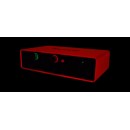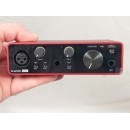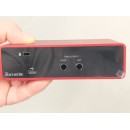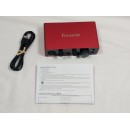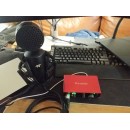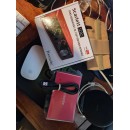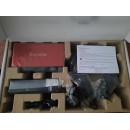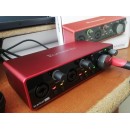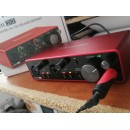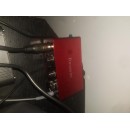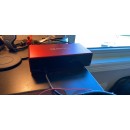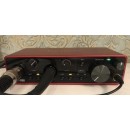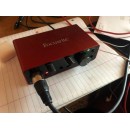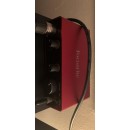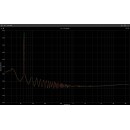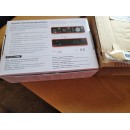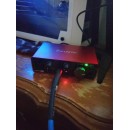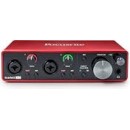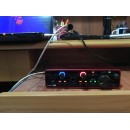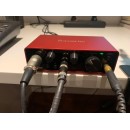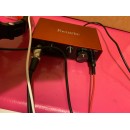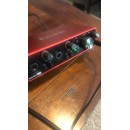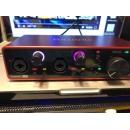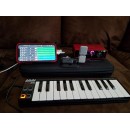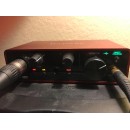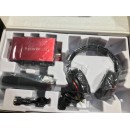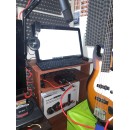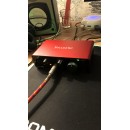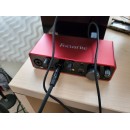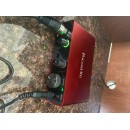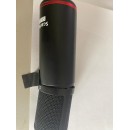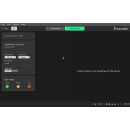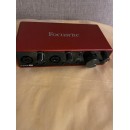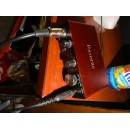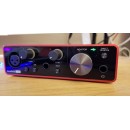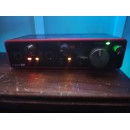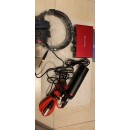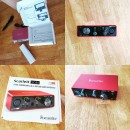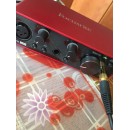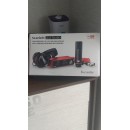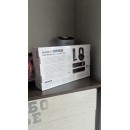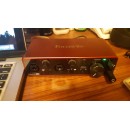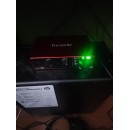Universal Audio Volt 1 vs. Focusrite Scarlett Solo (4th Gen): A Comprehensive Comparison
The Focusrite Scarlett Solo (4th Gen) is renowned for its simplicity and high-quality audio performance. It features a single XLR input with Focusrite's acclaimed mic preamps, delivering clear and transparent recordings. The 4th Generation model includes an upgraded Air mode, which adds brightness and presence to vocals and acoustic instruments. With a robust metal chassis, the Scarlett Solo is built to withstand the rigors of mobile recording. It supports sample rates up to 192kHz, ensuring professional-grade audio fidelity. The USB-C connectivity ensures fast, reliable data transfer, and the interface is bundled with a comprehensive software suite, including Ableton Live Lite, Pro Tools First, and Focusrite's own plugin collection.
On the other hand, the Universal Audio Volt 1 stands out with its vintage-inspired analog sound. It features a single XLR input equipped with a Vintage Mic Preamp mode, emulating the rich, warm tones of Universal Audio's classic 610 tube preamp. This makes it particularly appealing for users seeking a distinctive, characterful sound. The Volt 1 also includes a 1/4" Hi-Z input for direct instrument recording and MIDI I/O for connecting external MIDI gear. Like the Scarlett Solo, it supports 24-bit/192kHz audio resolution and uses USB-C for connectivity. The Volt 1 comes with a software bundle that includes Ableton Live Lite, UJAM's Virtual Drummer, Marshall Plexi Classic Amp, and more, catering to a wide range of creative needs.
Both interfaces are compact and portable, making them ideal for on-the-go recording. However, the choice between them largely hinges on the user’s preference for sound character and additional features. The Scarlett Solo is perfect for those who prioritize clean, transparent recordings and a straightforward setup. In contrast, the Volt 1 is ideal for users who desire a vintage, warm sound with the added flexibility of MIDI connectivity. Both devices offer excellent value and high-quality performance, making them strong contenders in the entry-level audio interface market.
Specifications, Advantages, and Disadvantages of Universal Audio Volt 1 and Focusrite Scarlett Solo (4th Gen)
| User Rating Based on Analysis of Reviews | |
|---|---|
|
Show More |
| Pros: | |
|---|---|
|
|
| Cons: | |
|---|---|
|
|
| Key Specs | |
|---|---|
| Channels of I/O | |
| Analog: 1 Input / 2 Outputs |
Analog: 2 Inputs / 2 Outputs at 192 kHz |
| Maximum Sampling Rate | |
| 192 kHz / 24-Bit | 192 kHz / 24-Bit |
| Number of Microphone Inputs | |
| 1 Preamp | 1 |
| Analog Audio I/O | |
| 1x Combo XLR-1/4" TRS Balanced/Unbalanced Mic/Line/Hi-Z Input (Front Panel) 2x 1/4" TRS Balanced Monitor Output 1x 1/4" TRS Unbalanced Headphone Output (Front Panel) |
1x XLR 3-Pin Balanced Mic Input 1x 1/4" TS Unbalanced Line/Hi-Z Input (Front Panel) 2x 1/4" TRS Balanced Monitor Output 1x 1/4" TRS Headphone Output (Front Panel) |
| Host Connection | |
| 1x USB-C | 1x USB-C |
| OS Compatibility | |
| macOS 10.14 or Later Windows 10 (64-Bit Only) 14 or Later iPadOS 14 or Later |
macOS Windows |
| Power Requirements | |
| AC/DC Power Adapter (Not Included) or USB Bus Power | USB Bus Power, USB Power Adapter (Not Included) |
The Focusrite Scarlett Solo offers 2 analog inputs and 2 outputs at a maximum sampling rate of 192 kHz / 24-bit. It includes 1 microphone input through an XLR 3-pin balanced mic input and a 1/4" TS unbalanced line/Hi-Z input on the front panel. For outputs, it provides dual 1/4" TRS balanced monitor outputs and a 1/4" TRS headphone output on the front panel. The Scarlett Solo connects to the host via a USB-C port and is compatible with both macOS and Windows. It is powered through USB bus power or an optional USB power adapter, although the adapter is not included.
On the other hand, the Universal Audio Volt 1 features a single analog input and 2 outputs, also supporting a maximum sampling rate of 192 kHz / 24-bit. It includes 1 preamp for the microphone input, which is accessible through a combo XLR-1/4" TRS balanced/unbalanced mic/line/Hi-Z input on the front panel. For outputs, it provides 2x 1/4" TRS balanced monitor outputs and a 1/4" TRS unbalanced headphone output on the front panel. The Volt 1 connects via a USB-C port and is compatible with macOS 10.14 or later, Windows 10 (64-bit only), and iPadOS 14 or later. It can be powered through an AC/DC power adapter (not included) or USB bus power.
In summary, while both interfaces support similar sampling rates and bit depths, the Focusrite Scarlett Solo offers an additional analog input channel. The Scarlett Solo is designed for straightforward macOS and Windows compatibility, whereas the Volt 1 extends its compatibility to include newer iPadOS versions. Both interfaces offer similar connectivity options, but the Volt 1 includes a versatile combo input for flexibility. Powering options for both include USB bus power, with the Scarlett Solo also being able to use an optional USB power adapter, and the Volt 1 accommodating an optional AC/DC power adapter.
| General | |
|---|---|
| Channels of I/O | |
| Analog: 1 Input / 2 Outputs |
Analog: 2 Inputs / 2 Outputs at 192 kHz |
| Maximum Sampling Rate | |
| 192 kHz / 24-Bit | 192 kHz / 24-Bit |
| Number of Microphone Inputs | |
| 1 Preamp | 1 |
| Input Level Adjustment | |
| 1x Knob | 2x Knob |
| Expansion Slots | |
The Focusrite Scarlett Solo offers 2 analog inputs and 2 analog outputs, both capable of operating at a maximum sampling rate of 192 kHz at 24-bit resolution. It accommodates a single microphone input and relies on two knobs for input level adjustment, allowing for more nuanced control over input levels. Despite lacking built-in DSP and expansion slots, the Scarlett Solo is recognized for its user-friendly interface and high-quality preamps.
In comparison, the Universal Audio Volt 1 provides 1 analog input and 2 analog outputs, also supporting up to 192 kHz at 24-bit resolution. It features one microphone preamp input and uses a single knob for input level adjustment, which may be simpler but limits the granularity of control compared to the Scarlett Solo. Like the Scarlett Solo, the Volt 1 lacks built-in DSP and expansion slots. However, Universal Audio is renowned for its audio quality and robust build, which may appeal to users prioritizing these aspects.
In summary, while both interfaces share a similar sampling rate and bit depth, the Focusrite Scarlett Solo offers greater input flexibility and more detailed input level control with its two knobs. The Universal Audio Volt 1, though more limited in input options, maintains high audio fidelity and a straightforward user experience. Both are excellent choices, with the best option depending on the specific needs and preferences of the user.
| Signal Processing |
|---|
| Connectivity | |
|---|---|
| Analog Audio I/O | |
| 1x Combo XLR-1/4" TRS Balanced/Unbalanced Mic/Line/Hi-Z Input (Front Panel) 2x 1/4" TRS Balanced Monitor Output 1x 1/4" TRS Unbalanced Headphone Output (Front Panel) |
1x XLR 3-Pin Balanced Mic Input 1x 1/4" TS Unbalanced Line/Hi-Z Input (Front Panel) 2x 1/4" TRS Balanced Monitor Output 1x 1/4" TRS Headphone Output (Front Panel) |
| Phantom Power | |
| 48 V, Selectable On/Off | 48 V, Selectable On/Off |
| Digital Audio I/O | |
| Host Connection | |
| 1x USB-C | 1x USB-C |
| Host Connection Protocol | |
| USB 2.0 | USB 2.0 |
| USB (Non-Host) | |
| Sync I/O | |
| Network I/O | |
| MIDI I/O | |
| 1x DIN 5-Pin Input 1x DIN 5-Pin Output |
|
In terms of analog audio inputs, the Focusrite Scarlett Solo features a single XLR 3-pin balanced mic input and a 1/4" TS unbalanced line/Hi-Z input on the front panel. This configuration is ideal for solo musicians and podcasters who need a straightforward setup for vocal and instrument recording. The Universal Audio Volt 1, on the other hand, offers a single combo XLR-1/4" TRS input that supports both balanced and unbalanced signals for mic, line, and Hi-Z sources. This combo input provides greater flexibility for various recording scenarios, accommodating different types of microphones and instruments with ease.
Both interfaces include 48V selectable phantom power, ensuring compatibility with condenser microphones that require external power. This feature can be turned on or off as needed.
For outputs, both the Scarlett Solo and Volt 1 are equipped with two 1/4" TRS balanced monitor outputs and a 1/4" TRS headphone output on the front panel. These outputs allow for clear and accurate monitoring of recordings through professional studio monitors and headphones.
Regarding digital audio I/O, neither the Scarlett Solo nor the Volt 1 includes additional digital audio input or output options. Both interfaces rely solely on their analog I/O for audio connectivity.
Both models use a USB-C host connection with USB 2.0 protocol, providing a stable and fast connection to the computer for seamless audio transfer and low-latency recording.
A distinguishing feature of the Universal Audio Volt 1 is its inclusion of MIDI I/O with 1x DIN 5-pin input and 1x DIN 5-pin output. This addition makes the Volt 1 a more versatile choice for users who need to integrate MIDI controllers, keyboards, or other MIDI-enabled devices into their recording setup. The Scarlett Solo does not offer MIDI I/O, which may be a limitation for users requiring MIDI connectivity.
In summary, while both the Focusrite Scarlett Solo and the Universal Audio Volt 1 offer similar core features such as high-quality analog I/O, phantom power, and USB-C connectivity, the Volt 1 stands out with its combo input flexibility and additional MIDI I/O, making it a more versatile option for diverse recording environments. The Scarlett Solo, however, remains a solid choice for users who prioritize simplicity and straightforward analog input options.
| Digital Audio | |
|---|---|
| Sample Rates | |
| Up to 192 kHz | 44.1 / 48 / 88.2 / 96 / 176.4 / 192 kHz |
| Bit Depths | |
| 24-Bit | 24-Bit |
| Sync Sources | |
| Internal | Internal |
In terms of sample rates, the Focusrite Scarlett Solo offers a range of 44.1, 48, 88.2, 96, 176.4, and 192 kHz, providing flexibility for various recording and playback scenarios. On the other hand, the Universal Audio Volt 1 supports sample rates up to 192 kHz, which also ensures high-resolution audio recording but does not specify the intermediate sample rates available.
Both interfaces support a bit depth of 24-bit, which is standard for professional audio quality, ensuring detailed and dynamic sound recording.
The Focusrite Scarlett Solo relies on internal sync sources, ensuring stability and precision in audio timing without needing external synchronization. Similarly, the Universal Audio Volt 1 also uses internal sync sources, guaranteeing consistent and reliable audio performance.
A distinguishing feature of the Universal Audio Volt 1 is its zero-latency direct monitoring, which allows you to monitor your recording input in real-time without any noticeable delay. This can be crucial for musicians and vocalists who need immediate feedback while recording. The Focusrite Scarlett Solo does not explicitly mention zero-latency monitoring but is known for its low-latency performance.
In summary, both the Focusrite Scarlett Solo (4th Generation) and the Universal Audio Volt 1 are robust audio interfaces with 24-bit depth and internal sync sources. The Scarlett Solo offers a broader range of sample rates, while the Volt 1 emphasizes zero-latency direct monitoring for real-time audio feedback.
| Audio Storage & Playback |
|---|
| Compatibility | |
|---|---|
| OS Compatibility | |
| macOS 10.14 or Later Windows 10 (64-Bit Only) 14 or Later iPadOS 14 or Later |
macOS Windows |
The Focusrite Scarlett Solo USB-C Audio Interface (4th Generation) is compatible with macOS and Windows operating systems, and also offers compatibility with iPadOS, making it versatile for mobile setups. This makes it a suitable choice for users who want to integrate their iPad into their recording workflow. However, detailed specifications regarding processor requirements and additional hardware are not explicitly mentioned.
On the other hand, the Universal Audio Volt 1 USB-C Audio/MIDI Interface provides a more detailed list of compatible devices and operating systems. It supports macOS 10.14 or later, Windows 10 (64-bit only), and iPadOS 14 or later. Additionally, it is compatible with various Apple devices such as iPad Pro, iPad, and iPhone. The processor requirements for the Volt 1 are specified, supporting both Intel and Apple M1 processors for Mac, and Intel and AMD processors for PC, ensuring a broad range of compatibility. The necessary hardware for operation includes an available USB 2.0 port and an included USB cable. An internet connection is also required for registration and downloading necessary software or drivers.
In conclusion, while both interfaces offer solid compatibility with macOS and Windows, the Universal Audio Volt 1 goes a step further by specifying processor requirements and a broader range of compatible mobile devices, alongside necessary hardware and internet requirements for setup and operation. The Focusrite Scarlett Solo, while also versatile with mobile app compatibility, does not provide the same level of detail in its specifications.
| Power | |
|---|---|
| Power Requirements | |
| AC/DC Power Adapter (Not Included) or USB Bus Power | USB Bus Power, USB Power Adapter (Not Included) |
| AC/DC Power Adapter | |
| 5 VDC (Not Included) | 5 VDC at 900 mA |
The Focusrite Scarlett Solo operates on USB bus power and has the option to use a USB power adapter, although it is not included with the product. It also allows for an AC/DC power adapter with a specification of 5 VDC at 900 mA. The power consumption for the Focusrite Scarlett Solo is specified at 4.5 W.
On the other hand, the Universal Audio Volt 1 also supports USB bus power and can alternatively be powered by an AC/DC power adapter, which, similar to the Focusrite, is not included in the package. The required specification for the AC/DC power adapter is 5 VDC, but the exact current rating is not specified in the available details.
In essence, both interfaces are designed to be versatile in terms of power options, accommodating both USB bus power and AC/DC adapters. However, the Focusrite Scarlett Solo provides a specific power consumption figure and detailed current requirements for the AC/DC adapter, which might be useful for users who need precise power management. The Universal Audio Volt 1, while flexible in its power options, does not specify the current requirement for the AC/DC adapter, potentially leaving a slight gap in the detailed power specification.
| Physical |
|---|
| Packaging Info | |
|---|---|
| Package Weight | |
| 1.945 lb | 1.305 lb |
| Box Dimensions (LxWxH) | |
| 8.1 x 7.7 x 3.8" | 7.2 x 6.1 x 2.5" |
The Focusrite Scarlett Solo comes in a package weighing 1.305 lb, and its box dimensions are 7.2 x 6.1 x 2.5 inches. This makes it relatively lightweight and compact, which could be advantageous for users who need a portable and easy-to-store audio interface. The smaller size and weight may also suggest a more simplified setup, potentially appealing to solo artists or those with limited desk space.
In contrast, the Universal Audio Volt 1 is packaged in a box that weighs 1.945 lb, with dimensions of 8.1 x 7.7 x 3.8 inches. This indicates a bulkier and heavier unit compared to the Focusrite Scarlett Solo. The increased weight and larger box size might be indicative of more robust construction or additional internal components, which could appeal to users looking for a more substantial and potentially more durable interface. The larger dimensions may also allow for more extensive controls and connectivity options, catering to users who require a more versatile setup.
In summary, the Focusrite Scarlett Solo is lighter and more compact, making it ideal for portability and simpler configurations. On the other hand, the Universal Audio Volt 1, with its heavier weight and larger dimensions, may offer a more durable build and potentially more features, suitable for users seeking a more comprehensive audio interface solution.
| Customer Images | |
|---|---|
| Videos | |
|---|---|
|
|
|
